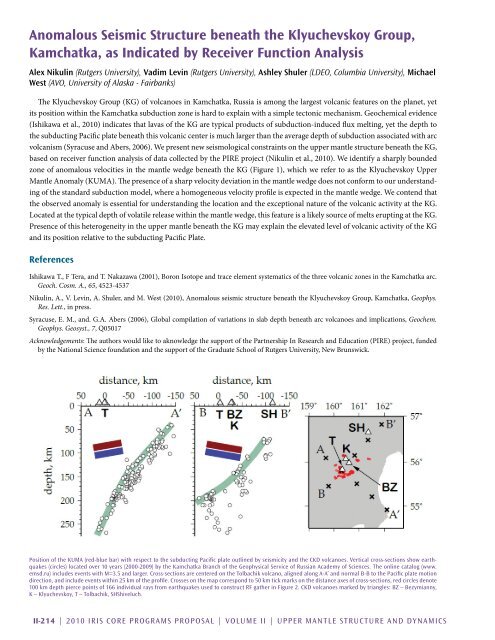Download Volume II Accomplisments (28 Mb pdf). - IRIS
Download Volume II Accomplisments (28 Mb pdf). - IRIS
Download Volume II Accomplisments (28 Mb pdf). - IRIS
Create successful ePaper yourself
Turn your PDF publications into a flip-book with our unique Google optimized e-Paper software.
Anomalous Seismic Structure beneath the Klyuchevskoy Group,<br />
Kamchatka, as Indicated by Receiver Function Analysis<br />
Alex Nikulin (Rutgers University), Vadim Levin (Rutgers University), Ashley Shuler (LDEO, Columbia University), Michael<br />
West (AVO, University of Alaska - Fairbanks)<br />
The Klyuchevskoy Group (KG) of volcanoes in Kamchatka, Russia is among the largest volcanic features on the planet, yet<br />
its position within the Kamchatka subduction zone is hard to explain with a simple tectonic mechanism. Geochemical evidence<br />
(Ishikawa et al., 2010) indicates that lavas of the KG are typical products of subduction-induced flux melting, yet the depth to<br />
the subducting Pacific plate beneath this volcanic center is much larger than the average depth of subduction associated with arc<br />
volcanism (Syracuse and Abers, 2006). We present new seismological constraints on the upper mantle structure beneath the KG,<br />
based on receiver function analysis of data collected by the PIRE project (Nikulin et al., 2010). We identify a sharply bounded<br />
zone of anomalous velocities in the mantle wedge beneath the KG (Figure 1), which we refer to as the Klyuchevskoy Upper<br />
Mantle Anomaly (KUMA). The presence of a sharp velocity deviation in the mantle wedge does not conform to our understanding<br />
of the standard subduction model, where a homogeneous velocity profile is expected in the mantle wedge. We contend that<br />
the observed anomaly is essential for understanding the location and the exceptional nature of the volcanic activity at the KG.<br />
Located at the typical depth of volatile release within the mantle wedge, this feature is a likely source of melts erupting at the KG.<br />
Presence of this heterogeneity in the upper mantle beneath the KG may explain the elevated level of volcanic activity of the KG<br />
and its position relative to the subducting Pacific Plate.<br />
References<br />
Ishikawa T., F Tera, and T. Nakazawa (2001), Boron Isotope and trace element systematics of the three volcanic zones in the Kamchatka arc.<br />
Geoch. Cosm. A., 65, 4523-4537<br />
Nikulin, A., V. Levin, A. Shuler, and M. West (2010), Anomalous seismic structure beneath the Klyuchevskoy Group, Kamchatka, Geophys.<br />
Res. Lett., in press.<br />
Syracuse, E. M., and. G.A. Abers (2006), Global compilation of variations in slab depth beneath arc volcanoes and implications, Geochem.<br />
Geophys. Geosyst., 7, Q05017<br />
Acknowledgements: The authors would like to aknowledge the support of the Partnership In Research and Education (PIRE) project, funded<br />
by the National Science foundation and the support of the Graduate School of Rutgers University, New Brunswick.<br />
Position of the KUMA (red-blue bar) with respect to the subducting Pacific plate outlined by seismicity and the CKD volcanoes. Vertical cross-sections show earthquakes<br />
(circles) located over 10 years (2000-2009) by the Kamchatka Branch of the Geophysical Service of Russian Academy of Sciences. The online catalog (www.<br />
emsd.ru) includes events with M=3.5 and larger. Cross-sections are centered on the Tolbachik volcano, aligned along A-A’ and normal B-B to the Pacific plate motion<br />
direction, and include events within 25 km of the profile. Crosses on the map correspond to 50 km tick marks on the distance axes of cross-sections, red circles denote<br />
100 km depth pierce points of 166 individual rays from earthquakes used to construct RF gather in Figure 2. CKD volcanoes marked by triangles: BZ – Bezymianny,<br />
K – Klyuchevskoy, T – Tolbachik, SHShiveluch.<br />
<strong>II</strong>-214 | 2010 <strong>IRIS</strong> Core Programs Proposal | <strong>Volume</strong> <strong>II</strong> | Upper Mantle Structure and Dynamics
















